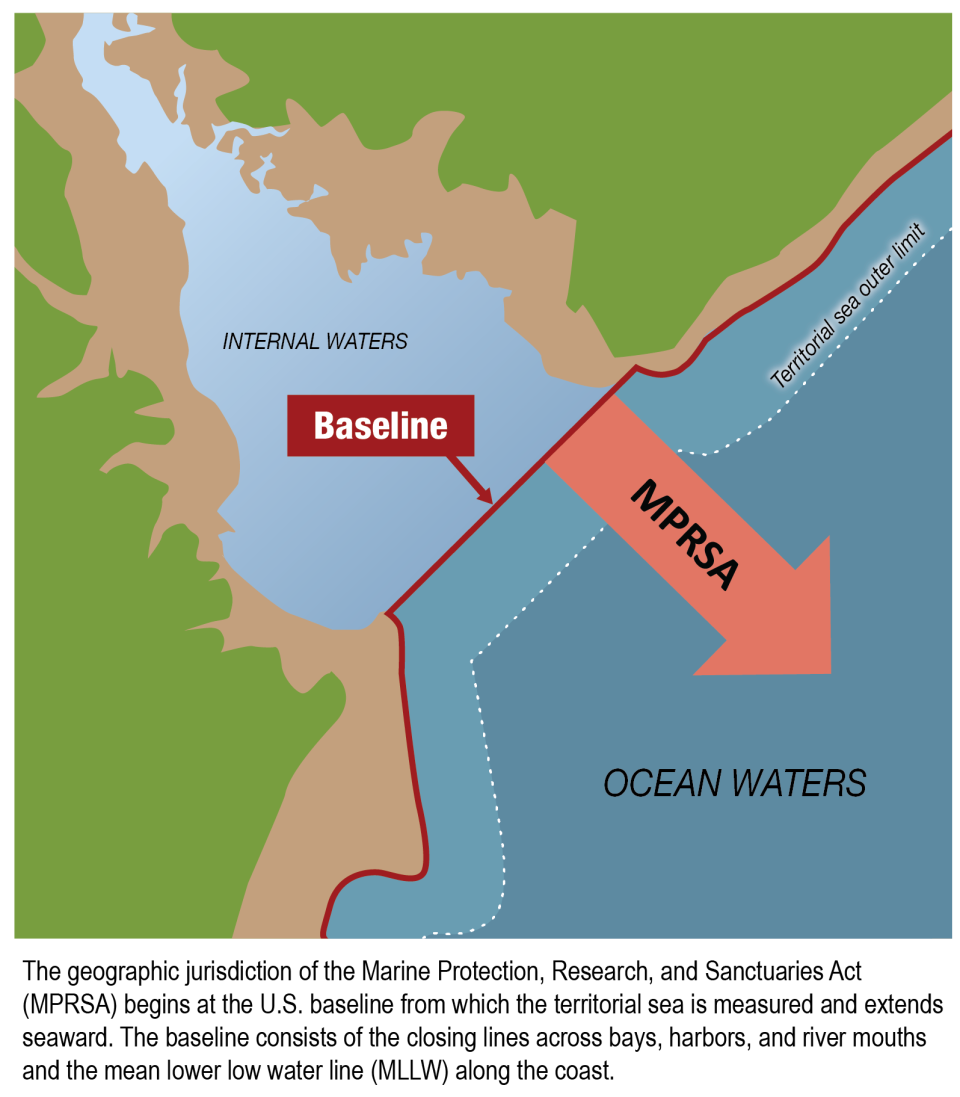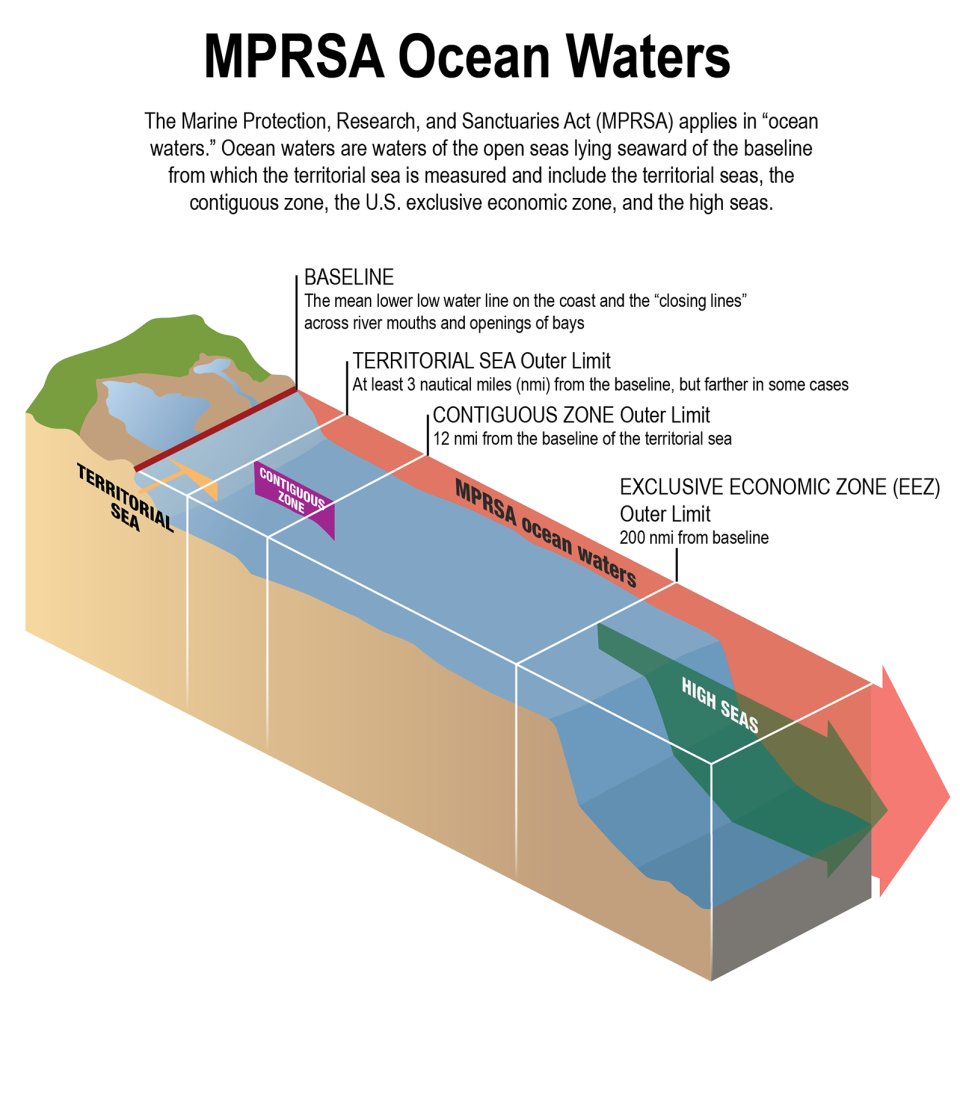Regulation of mCDR under the MPRSA and CWA Section 402
If a proposed mCDR activity (including field research and pilot studies) involves the disposition of material into marine waters, then a permit or authorization under the Marine Protection, Research and Sanctuaries Act (MPRSA) or the Clean Water Act may be required. Below, view information and resources related to permitting for mCDR activities under EPA-administered permitting programs.
On this page:
- London Convention and London Protocol International Treaties
- Permit Types for mCDR Activities
- Other Applicable Laws and Policies
London Convention and London Protocol International Treaties
The London Convention and London Protocol are two international treaties that protect the marine environment from pollution caused by the dumping of wastes and other matter into the ocean. The Marine Protection, Research and Sanctuaries Act (MPRSA) implements the requirements of the London Convention in the United States.
Since 2007, the Parties to the London Convention and London Protocol have been working to establish a global, transparent, and effective regulatory mechanism for ocean fertilization and other marine geoengineering activities that fall within the scope of the London Convention and London Protocol.
Permit Types for mCDR Activities
Depending on case-specific facts of the proposed mCDR activity, including the specific type and location of the activity, a permit may be required under one of the following permitting programs under statutes administered by the EPA:
- Marine Protection, Research and Sanctuaries Act
- Clean Water Act Section 402- National Pollutant Discharge Elimination System
Regardless of the applicable statutory permitting program, the permitting process generally includes:
-
An assessment of the project to ensure that the proposed activity will not unreasonably degrade the environment or endanger human health.
-
Opportunities for public review and comment on the proposed activities.
-
Coordination with other Tribal, federal, state, and local entities as appropriate including considerations under Clean Water Act 401, Endangered Species Act, Magnuson Stevens Fishery Conservation and Management Act, and Coastal Zone Management Act.
When is an MPRSA Permit Required?
Unless specifically excluded or exempt from MPRSA, an MPRSA permit is needed to authorize the transportation and "dumping" of any material into "ocean waters". Section 106 of the MPRSA voids any licenses, permits, and authorizations other than MPRSA permits that purport to authorize activities regulated by the MPRSA. An MPRSA permit is not needed for activities that are specifically exempt from permitting under the MPRSA or for the disposition of material from activities that do not occur in ocean waters.
Examples of activities that do not require an MPRSA permit:
- Discharges of effluent from an "outfall structure" regulated under the Clean Water Act are exempt from the MPRSA and do not require an MPRSA permit. See section on mCDR permitting under the Clean Water Act.
- Activities conducted in internal waters, (e.g., a bay, harbor, or other waterbody landward of ocean waters) are not subject to MPRSA but may be regulated under other federal, state or local laws. MPRSA does not apply to waters landward of the baseline.
"Dumping" means a disposition of material. The MPRSA uses the term "dumping"; that term is defined broadly to encompass the disposition of material both for the purpose of disposal and purposes other than disposal. There are exemptions to the definition of dumping, including when "construction of a fixed structure or artificial island" or "placement of a device" is for a purpose other than disposal and where the construction or placement is otherwise regulated under another law.
The MPRSA applies in "ocean waters." Ocean waters include the open seas lying seaward of the "baseline" of the territorial seas. In general terms, the baseline is the mean lower low water line, or ordinary low water mark, along the coast and the "closing lines" across rivers mouths and openings of bays that are depicted on official United States Nautical Charts.
"Ocean waters" for the purposes of the MPRSA include:
- The territorial seas (the first three nautical miles seaward of the baseline).
- The contiguous zone (the next nine nautical miles from three to twelve nautical miles seaward of the baseline).
- The exclusive economic zone of the United States (out to 200 nautical miles).
- The high seas beyond the exclusive economic zone of the United States extending to the exclusive economic zone of another country.


An MPRSA permit would be needed by:
- Anyone transporting material from the United States for the purpose of dumping it into ocean waters.
- Anyone in a vessel or aircraft registered in the United States or flying the United States flag transporting material from any location for the purpose of dumping it into ocean waters.
- Any United States department, agency or instrumentality transporting material from any location for the purpose of dumping it into ocean waters.
- Any other person dumping material transported from a location outside the United States into the territorial sea of the United States, or into a zone contiguous to the territorial sea of the United States, to the extent that it may affect the territorial sea or the territory of the United States.
Examples of mCDR activities that may require authorization under an MPRSA permit include:
- Transportation and disposition of mCDR-related materials into the ocean. For example, transporting alkaline solutions, alkaline minerals or iron solutions or solids to ocean waters via vessel or aircraft and releasing the materials into those waters.
- Transporting and sinking biomass (e.g., macroalgae or terrestrial biomass) by or from a vessel into the ocean.
Additional information about MPRSA permits for mCDR activities:
When is a Clean Water Act NPDES Permit Required?
In general, discharges of pollutants from point sources into waters of the United States are regulated under the Clean Water Act and require a National Pollutant Discharge Elimination System (NPDES) permit. mCDR activities that result in the discharge of effluent (e.g., alkaline solution, CO2-depleted water) through an outfall structure into ocean waters, or otherwise are exempt from the MPRSA, are regulated under the Clean Water Act by an NPDES permit that applies the ocean discharge criteria (Clean Water Act section 403) and other Clean Water Act requirements.
The facility discharging the effluent to ocean waters could be on land, a fixed structure at sea, or a facility onboard a vessel or floating craft operating in a capacity other than as a means of transportation. For example, EPA has issued NPDES permits for discharges associated with a variety of industrial activities into marine water including offshore oil and gas exploration, production and development; aquaculture; and offshore seafood processing facilities.
Additionally, mCDR activities that result in discharges inside a bay, harbor, or body of water landward of the baseline may require authorization under a Clean Water Act NPDES permit and are not subject to MPRSA permitting, as MPRSA jurisdiction does not include waters inside the baseline of the territorial sea.
Examples of mCDR activities that may require authorization under a Clean Water Act NPDES permit:
- mCDR-related changes to the effluent discharge at an existing wastewater treatment plant facility (e.g., additions of alkaline solutions or materials). These would be regulated under the NPDES permit for that facility. In this case, the mCDR project applicant would communicate with the current NPDES permittee and the regulatory authority to ensure that any mCDR-related changes in the facility's discharges remain with the scope of the authorization of the existing NPDES permit or whether an NPDES permit modification is necessary because the original permit application did not disclose the mCDR-related change.
- Discharges (e.g., alkaline solutions) not into ocean waters (e.g., internal waters located inside the closing line of a bay, harbor or river mouth) would require NPDES permit authorization rather than authorization under the MPRSA.
Additional Information on NPDES permits:
- General information about NPDES permits, including FAQs
- More information on permit application forms for EPA-issued NPDES permits
Other Applicable Laws and Policies
The applicable Tribal, federal, state or local laws or policies that apply to a proposed mCDR activity depend on the location and the nature of the mCDR activity.
For state-issued CWA 402 NPDES permits, project applicants should discuss their project with the state permitting agency to identify applicable Tribal, state, or local requirements.
Federal actions, such as funding, conducting, or permitting a project, are subject to certain federal laws and agency policies. For example:
- The EPA follows the agency’s Policy on Consultation with Indian Tribes.
- If the proposed activities may affect the waters of a Tribe, state, or territory, coordination with those entities regarding analyses of potential impacts to coastal resources or water quality may be required (see Coastal Zone Management Act (CZMA) and Clean Water Act Section 401).
- If the proposed activities may affect habitats for protected species, essential fish habitats, or a national marine sanctuary, coordination or consultation with NOAA Fisheries, NOAA Office of National Marine Sanctuaries, and/or U.S. Fish and Wildlife Service may be required.
The EPA may assist project applicants in determining which federal laws or policies would apply to their proposed activity and discuss how these requirements would be incorporated into the permitting process.
